What's inside
What's inside
 Key Ingredients
Key Ingredients

 Benefits
Benefits

 Concerns
Concerns

 Ingredients Side-by-side
Ingredients Side-by-side

Hydrolyzed Collagen Extract 70.23%
Skin ProtectingSimmondsia Chinensis Seed Oil
EmollientPolyvinyl Alcohol
Methylpropanediol
Solvent1,2-Hexanediol
Skin ConditioningAlgin
MaskingPolysorbate 80
EmulsifyingCaprylic/Capric Triglyceride
MaskingPolyglyceryl-10 Oleate
Skin ConditioningPullulan
Oenothera Biennis Flower Extract
AstringentUlmus Davidiana Root Extract
Skin ConditioningPinus Palustris Leaf Extract
TonicPueraria Lobata Root Extract
HumectantDiospyros Kaki Leaf Extract
Skin ProtectingCamellia Sinensis Leaf Extract
AntimicrobialCastanea Crenata Shell Extract
Skin ConditioningCarthamus Tinctorius Flower Extract
Skin ConditioningZanthoxylum Piperitum Fruit Extract
Skin ConditioningCoffea Arabica Seed Extract
MaskingVitis Vinifera Fruit Extract
Skin ConditioningPolygonum Cuspidatum Root Extract
AntioxidantSodium Hyaluronate
HumectantGlyceryl Stearate
EmollientPanthenol
Skin ConditioningDisteardimonium Hectorite
StabilisingSodium Polystyrene Sulfonate
Emulsion StabilisingWater
Skin ConditioningCellulose Gum
Emulsion StabilisingTocopheryl Acetate
AntioxidantAllantoin
Skin ConditioningButylene Glycol
HumectantSodium Phytate
Lactobacillus Ferment
Skin ConditioningGlycine
BufferingSerine
MaskingGlutamic Acid
HumectantAspartic Acid
MaskingLeucine
Skin ConditioningLysine
Skin ConditioningAlanine
MaskingArginine
MaskingValine
MaskingIsoleucine
Skin ConditioningTyrosine
MaskingThreonine
Phenylalanine
MaskingProline
Skin ConditioningHistidine
HumectantMethionine
Skin ConditioningCysteine
AntioxidantSodium Acetylated Hyaluronate
HumectantHydrolyzed Hyaluronic Acid
HumectantPEG-100 Stearate
Parfum
MaskingEthylhexylglycerin
Skin ConditioningHydrolyzed Collagen Extract 70.23%, Simmondsia Chinensis Seed Oil, Polyvinyl Alcohol, Methylpropanediol, 1,2-Hexanediol, Algin, Polysorbate 80, Caprylic/Capric Triglyceride, Polyglyceryl-10 Oleate, Pullulan, Oenothera Biennis Flower Extract, Ulmus Davidiana Root Extract, Pinus Palustris Leaf Extract, Pueraria Lobata Root Extract, Diospyros Kaki Leaf Extract, Camellia Sinensis Leaf Extract, Castanea Crenata Shell Extract, Carthamus Tinctorius Flower Extract, Zanthoxylum Piperitum Fruit Extract, Coffea Arabica Seed Extract, Vitis Vinifera Fruit Extract, Polygonum Cuspidatum Root Extract, Sodium Hyaluronate, Glyceryl Stearate, Panthenol, Disteardimonium Hectorite, Sodium Polystyrene Sulfonate, Water, Cellulose Gum, Tocopheryl Acetate, Allantoin, Butylene Glycol, Sodium Phytate, Lactobacillus Ferment, Glycine, Serine, Glutamic Acid, Aspartic Acid, Leucine, Lysine, Alanine, Arginine, Valine, Isoleucine, Tyrosine, Threonine, Phenylalanine, Proline, Histidine, Methionine, Cysteine, Sodium Acetylated Hyaluronate, Hydrolyzed Hyaluronic Acid, PEG-100 Stearate, Parfum, Ethylhexylglycerin
Sea Water
HumectantGlycerin
HumectantButylene Glycol
HumectantCetyl Ethylhexanoate
Emollient1,2-Hexanediol
Skin ConditioningAlcohol Denat.
AntimicrobialNiacinamide
SmoothingGlycereth-26
HumectantAdenosine
Skin ConditioningHydrolyzed Collagen
EmollientHyaluronic Acid
HumectantHydrolyzed Hyaluronic Acid
HumectantSodium Hyaluronate
HumectantSoluble Collagen
HumectantCollagen Extract
Skin ConditioningAtelocollagen
Skin ConditioningPropanediol
SolventCyclopentasiloxane
EmollientTrehalose
HumectantCarbomer
Emulsion StabilisingCetearyl Olivate
Tromethamine
BufferingCyclohexasiloxane
EmollientSorbitan Olivate
EmulsifyingEthylhexylglycerin
Skin ConditioningDisodium EDTA
Dimethicone
EmollientParfum
MaskingSea Water, Glycerin, Butylene Glycol, Cetyl Ethylhexanoate, 1,2-Hexanediol, Alcohol Denat., Niacinamide, Glycereth-26, Adenosine, Hydrolyzed Collagen, Hyaluronic Acid, Hydrolyzed Hyaluronic Acid, Sodium Hyaluronate, Soluble Collagen, Collagen Extract, Atelocollagen, Propanediol, Cyclopentasiloxane, Trehalose, Carbomer, Cetearyl Olivate, Tromethamine, Cyclohexasiloxane, Sorbitan Olivate, Ethylhexylglycerin, Disodium EDTA, Dimethicone, Parfum
 Reviews
Reviews

Ingredients Explained
These ingredients are found in both products.
Ingredients higher up in an ingredient list are typically present in a larger amount.
1,2-Hexanediol is a synthetic liquid and another multi-functional powerhouse.
It is a:
- Humectant, drawing moisture into the skin
- Emollient, helping to soften skin
- Solvent, dispersing and stabilizing formulas
- Preservative booster, enhancing the antimicrobial activity of other preservatives
Butylene Glycol (or BG) is used within cosmetic products for a few different reasons:
Overall, Butylene Glycol is a safe and well-rounded ingredient that works well with other ingredients.
Though this ingredient works well with most skin types, some people with sensitive skin may experience a reaction such as allergic rashes, closed comedones, or itchiness.
Learn more about Butylene GlycolEthylhexylglycerin (we can't pronounce this either) is commonly used as a preservative and skin softener. It is derived from glyceryl.
You might see Ethylhexylglycerin often paired with other preservatives such as phenoxyethanol. Ethylhexylglycerin has been found to increase the effectiveness of these other preservatives.
Hydrolyzed Hyaluronic Acid is a form of hyaluronic acid. It is created by the hydrolysis of hyaluronic acid with a high molecular weight. Once created, Hydrolyzed Hyaluronic Acid has a low molecular weight.
Low molecular weight HA has been shown to hydrate and increase elasticity of the skin. Increasing elasticity is also associated with reduction of wrinkle depth.
One study found topical low molecular weight hyaluronic acid may be considered for the treatment of rosacea in the adult population. However, we always recommend speaking with a professional about your skin concerns.
Hyaluronic acids are a humectant. This means they draw moisture from the air. Hyaluronic acids help moisturize, soothe, and protect the skin.
Read more about other common forms of hyaluronic acid:
Learn more about Hydrolyzed Hyaluronic AcidParfum is a catch-all term for an ingredient or more that is used to give a scent to products.
Also called "fragrance", this ingredient can be a blend of hundreds of chemicals or plant oils. This means every product with "fragrance" or "parfum" in the ingredients list is a different mixture.
For instance, Habanolide is a proprietary trade name for a specific aroma chemical. When used as a fragrance ingredient in cosmetics, most aroma chemicals fall under the broad labeling category of “FRAGRANCE” or “PARFUM” according to EU and US regulations.
The term 'parfum' or 'fragrance' is not regulated in many countries. In many cases, it is up to the brand to define this term.
For instance, many brands choose to label themselves as "fragrance-free" because they are not using synthetic fragrances. However, their products may still contain ingredients such as essential oils that are considered a fragrance by INCI standards.
One example is Calendula flower extract. Calendula is an essential oil that still imparts a scent or 'fragrance'.
Depending on the blend, the ingredients in the mixture can cause allergies and sensitivities on the skin. Some ingredients that are known EU allergens include linalool and citronellol.
Parfum can also be used to mask or cover an unpleasant scent.
The bottom line is: not all fragrances/parfum/ingredients are created equally. If you are worried about fragrances, we recommend taking a closer look at an ingredient. And of course, we always recommend speaking with a professional.
Learn more about ParfumSodium Hyaluronate is hyaluronic acid's salt form. It is commonly derived from the sodium salt of hyaluronic acid.
Like hyaluronic acid, it is great at holding water and acts as a humectant. This makes it a great skin hydrating ingredient.
Sodium Hyaluronate is naturally occurring in our bodies and is mostly found in eye fluid and joints.
These are some other common types of Hyaluronic Acid:
Learn more about Sodium Hyaluronate